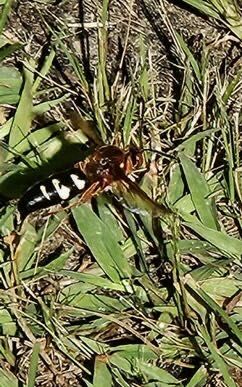Eastern Cicada Killer
Scientific Name: Sphecius speciosus
Order & Family: Order: Hymenoptera, Family: Crabronidae (or Sphecidae, depending on classification system)
Size: Females: 1.5 to 2 inches (3.8 to 5.1 cm), Males: 0.75 to 1.5 inches (1.9 to 3.8 cm)

Natural Habitat
Cicada killers prefer areas with loose, sandy, or well-drained soil for burrowing, such as gardens, lawns, golf courses, and along the edges of woods. They are often found wherever cicadas are abundant.
Diet & Feeding
Adult cicada killers primarily feed on nectar and tree sap. The larvae feed on paralyzed cicadas that the female wasp provides.
Behavior Patterns
Cicada killers are solitary wasps. Females dig burrows in the ground, often in sandy or loose soil, where they lay their eggs. They paralyze cicadas with their venom and carry them back to their burrows to provision their nests. Each paralyzed cicada serves as food for a single larval wasp. Adult cicada killers are often seen flying low to the ground and are most active during the summer months when cicadas are present. Males are territorial and defend their mating territories.
Risks & Benefits
Potential Risks: Female cicada killers have a sting which can be painful to humans, though they are generally not aggressive unless provoked or handled. They are more interested in cicadas than people. Males do not have a stinger but may dive-bomb to intimidate. Their burrowing activity can be a nuisance in lawns or gardens if numerous. Potential Benefits: Cicada killers are natural predators of cicadas, which can be beneficial in controlling cicada populations, especially in areas where cicadas might be considered pests due to their sound or tree damage (though cicada damage is usually not severe). They are also pollinators when feeding on nectar.
Identified on: 8/10/2025